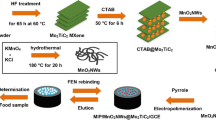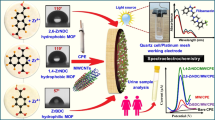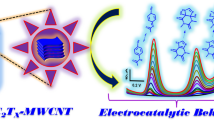Abstract
In this paper, a high adsorption performance of erythromycin molecularly imprinted polymer (ERY@MIP) was prepared by bulk polymerization. Scanning electron microscope, thermogravimetric analysis, and Fourier transform infrared spectroscopy were used to characterize the morphology and structure of imprinted polymers. The maximum adsorption capacity of ERY@MIP for ERY was 1048.8 mg g−1; it also has good selectivity compare with other antibiotics. Further, the thermodynamic and kinetic analysis shows that the experiment results accord with the Langmuir model and the quasi-second-order kinetic model, respectively.











Similar content being viewed by others
References
Li J, Ji F, Ng DHL, Liu J, Bing X, Wang P (2019) Bioinspired Pt-free molecularly imprinted hydrogel-based magnetic Janus micromotors for temperature-responsive recognition and adsorption of erythromycin in water. Chem Eng J 369:611–620
Saha S, Savage PB, Bal M (2008) Enhancement of the efficacy of erythromycin in multiple antibiotic-resistant gram-negative bacterial pathogens. J Appl Microbiol 105:822–828
Jaglic Z, Vlkova H, Bardon J, Michu E, Cervinkova D, Babak V (2012) Distribution, characterization and genetic bases of erythromycin resistance in staphylococci and enterococci originating from livestock. Zoonoses Public Hlth 59:202–211
Hoy SR, Vucetich JA, Liu R, DeAngelis DL, Peterson RO, Vucetich LM, Henderson JJ (2019) Negative frequency‐dependent foraging behaviour in a generalist herbivore (Alces alces) and its stabilizing influence on food web dynamics. J Anim Ecol 88:1291–1304
Jafari S (2012). Int J Dairy Technol 70:1–10
Scott HM, Acuff G, Bergeron G, Bourassa MW, Gill J, Graham DW, Kahn LH, Morley PS, Salois MJ, Simjee S, Singer RS, Smith TC, Storrs C, Wittum TE (2019) Critically important antibiotics: criteria and approaches for measuring and reducing their use in food animal agriculture. Ann N Y Acad Sci 1441:8–16
Di Salvo A, Rocca G, Cagnardi P, Pellegrino RM (2013) Pharmacokinetics and residue depletion of erythromycin in rainbow trout Oncorhynchus mykiss (Walbaum). J Fish Dis 36:1021–1029
Zhao L, Cao W, Xue X, Wang M, Wu L, Yu L (2017) Occurrence of erythromycin and its degradation products residues in honey. Validation of an analytical method. J Sep Sci 40:1353–1360
Naik KM, Nandibewoor ST (2016) Investigation into the interaction of methylparaben and erythromycin with human serum albumin using multispectroscopic methods. Luminescence 31:433–441
Bhushan R, Gupta D (2005) Thin-layer chromatography separation of enantiomers of verapamil using macrocyclic antibiotic as a chiral selector. Biomed Chromatogr 19:474–478
Kucherenko E, Kanateva A, Kurganov A, Borisov R, Pirogov A (2018) Monolithic thin‐layer chromatography plates with covalently bonded matrix for hyphenation with matrix‐assisted laser desorption/ionization. J Sep Sci 41:4387–4393
Luiz DB, Genena AK, Virmond E, José HJ, Moreira RFPM, Gebhardt W, Schröder HF (2010) Identification of degradation products of erythromycin A arising from ozone and advanced oxidation process treatment. Water Environ Res 82:797–805
Cai Z, Deng X, Wang Q, Lai J, Xie H, Chen Y, Huang B, Lin G (2020) Core-shell granular activated carbon and its adsorption of trypan blue. J Clean Prod 242:118496
Ghaemi M, Absalan G, Sheikhian L (2014) Adsorption characteristics of Titan yellow and Congo red on CoFe2O4 magnetic nanoparticles. J Iran Chem Soc 11:1759–1766
Sabah E, Çelik MS (2005) Sepiolite: An effective bleaching adsorbent for the physical refining of degummed rapeseed oil. J Am Oil Chem Soc 82:911–916
Lu L, Samarasekera C, Yeow JTW (2015). J Appl Polym Sci 132:1–8
Al-Damkhi AM, Al-Ameeri RS, Jeffreys GV, Mumford CJ (1987). J Chem TechnolL Biot 37:215–228
Chi X, Tang Y, Zeng X (2016) Electrode reactions coupled with chemical reactions of oxygen, water and acetaldehyde in an ionic liquid: new approaches for sensing volatile organic compounds. Electrochim Acta 216:171–180
Streifel BC, Lundin JG, Sanders AM et al (2018). Macromol Biosci 18:1–10
Xu T, Shehzad MA, Wang X, Wu B, Ge L, Xu T (2020) Engineering leaf-like UiO-66-SO3H membranes for selective transport of cations. Nano-Micro Letters 12:51–63
Hong YQ, Guo X, Chen GH et al (2018). J Food Safety 38:1–7
Pleasance S, Kelly J, LeBlanc MD et al (1992) Determination of erythromycin A in salmon tissue by liquid chromatography with ionspray mass spectrometry. Bio Mass Spectrom 21:675–687
Zhu Y, Jiang D, Sun D, Yan Y, Li C (2016) Fabrication of magnetic imprinted sorbents prepared by Pickering emulsion polymerization for adsorption of erythromycin from aqueous solution. J Environ Chem Eng 4:3570–3579
Farajzadeh MA, Dehghani H, Yadeghari A, Khoshmaram L (2017). Biomed Chromatogr 31:1–9
Garcia R, Carreiro EP, Nunes J, da Silva MG, Freitas AMC, Burke AJ, Cabrita MJ (2016) Dual-layer solid-phase extraction based on molecular imprinting technology: Seeking a route to enhance selectivity for trace analysis of pesticide residues in olive oil. Electrophoresis 37:1916–1922
Prasad BB, Tiwari MP (2012) Biomed mater 339–391
Madhuri R, Roy E, Gupta K, Sharma PK (2014). Adv Biosens Bioelectron 9781118773:367–422
O’Shannessy DJ, Andersson LI, Mosbach K (1989) Molecular recognition in synthetic polymers. Enantiomeric resolution of amide derivatives of amino acids on molecularly imprinted polymers. J Mol Recognit 2:1–5
Bodbodak S, Hesari J, Peighambardoust SH, Mahkam M (2018) Selective decontamination of aflatoxin M1in milk by molecularly imprinted polymer coated on the surface of stainless steel plate. Int J Dairy Techeol 71:868–878
Liu J, Li L, Tang H et al (2015). J Sep Sci 8:3103–3109
Song B, Zhou Y, Jin H, Jing T, Zhou T, Hao Q, Zhou Y, Mei S, Lee YI (2014) Selective and sensitive determination of erythromycin in honey and dairy products by molecularly imprinted polymers based electrochemical sensor. Microchem J 116:183–190
Geng L, Kou X, Lei J, Su H, Ma G, Su Z (2012) Preparation, characterization and adsorption performance of molecularly imprinted microspheres for erythromycin using suspension polymerization. J Chem Technol Biot 87:635–642
Committee of National Pharmacopoeia, Pharmacopoeia of P.R. China (2015) M China Medical Science Press
Mollym W, Albert FC, Daniel WA (2007). J Chirality 19:179–183
Li H, Xie C, Fu X (2013) Electrochemiluminescence sensor for sulfonylurea herbicide with molecular imprinting core–shell nanoparticles/chitosan composite film modified glassy carbon electrode. Sensor Actuat B-Chem 181:858–866
Wu N, Luo Z, Ge Y, Guo P, du K, Tang W, du W, Zeng A, Chang C, Fu Q (2016) A novel surface molecularly imprinted polymer as the solid-phase extraction adsorbent for the selective determination of ampicillin sodium in milk and blood samples. J Pharm Anal 6:157–164
Zu B, Zhang Y, Guo X, Zhang H (2010) Preparation of molecularly imprinted polymers via atom transfer radical â bulkâ polymerization. J Pol Ym Sci Pol Chem 48:532–541
Allen RC, Stephens JT (2011) Reduced-oxidized difference spectral analysis and chemiluminescence-based Scatchard analysis demonstrate selective binding of myeloperoxidase to microbes. J Luminescence 26:208–213
Li DP, Zhang YR, Zhao XX, Zhao BX (2013) Magnetic nanoparticles coated by aminoguanidine for selective adsorption of acid dyes from aqueous solution. Chem Eng J 232:425–433
Ying X, Kang A, Zhu X, Li X (2019). J Appl Polym Sci 136:1–10
Jadda R, Madhumanchi S, Suedee R (2019). J Sep Sci 42:3599–3738
Huang Z, Zhang P, Yun Y (2017) Preparing molecularly imprinted membranes by phase inversion to separate kaempferol. J Polym Advan Technol 28:373–378
Xu M, Chai J, Hu N, Huang D, Wang Y, Huang X, Wei H, Yang Z, Zhang Y (2014) Facile synthesis of soluble functional graphene by reduction of graphene oxide via acetylacetone and its adsorption of heavy metal ions. Nanotechnology 25:395602–395612
Zhang R, Zhang J, Zhang X, Dou C, Han R (2014) Adsorption of Congo red from aqueous solutions using cationic surfactant modified wheat straw in batch mode: Kinetic and equilibrium study. J Taiwan Inst Chem E 45:2578–2583
Huang Z, Zhang Z, Xia Q et al (2017). J Appl Pol Ym Sci 134:1–7
Ye Y, Zhao Y, Ni L, Jiang K, Tong G, Zhao Y, Teng B (2016) Facile synthesis of unique NiO nanostructures for efficiently catalytic conversion of CH4 at low temperature. Appl Surf Sci 362:20–27
Long J, Liang B, Li S, Chen ZB (2017) Preparation and characterization of a novel molecularly imprinted polymer for the separation of glycyrrhizic acid. J Sep Sci 40:4847–4856
Zhang F, Lan J, Yang Y, Wei T, Tan R, Song W (2013) Adsorption behavior and mechanism of methyl blue on zinc oxide nanoparticles. J Nanopart Res 15:2034–2044
Lee YC, Kim JY, Shin HJ (2013) Removal of malachite green (MG) from aqueous solutions by adsorption, precipitation, and alkaline fading using Talc. Sep Sci Technol 48:1093–1101
Li C, Ma X, Zhang X, Wang R, Li X, Liu Q (2017) Preparation of magnetic molecularly imprinted polymer nanoparticles by surface imprinting by a sol-gel process for the selective and rapid removal of di-(2-ethylhexyl) phthalate from aqueous solution. J Sep Sci 40:1621–1628
Funding
This work was supported by the Innovation Fund of Small and Medium-sized Enterprises of Gansu province (Grant No. 1407GCCA013) and the Key Technology and Industrial Application Demonstration Project of High Quality and High Purity Nano Calcium Carbonate of Guangxi province (Grant No. 17202030-2).
Author information
Authors and Affiliations
Corresponding authors
Ethics declarations
Conflict of interest
There authors declare that they have no conflicts of interest.
Additional information
Publisher’s note
Springer Nature remains neutral with regard to jurisdictional claims in published maps and institutional affiliations.
Rights and permissions
About this article
Cite this article
Hou, L., Han, X. & Wang, N. High performance of molecularly imprinted polymer for the selective adsorption of erythromycin in water. Colloid Polym Sci 298, 1023–1033 (2020). https://doi.org/10.1007/s00396-020-04660-1
Received:
Revised:
Accepted:
Published:
Issue Date:
DOI: https://doi.org/10.1007/s00396-020-04660-1




